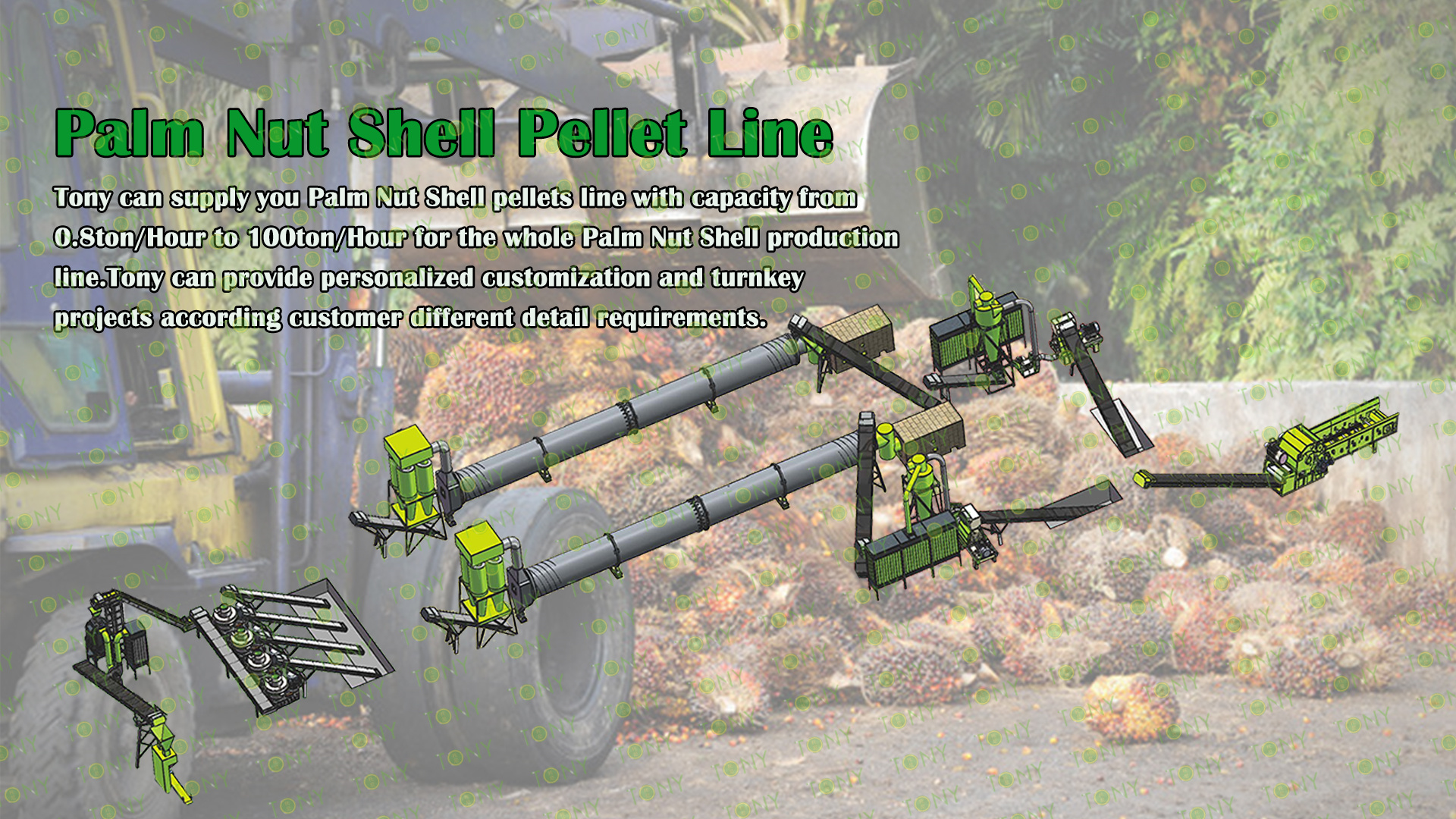
TONY Design 14-16Ton/Hour Palm Nut Shell Production Line Specification
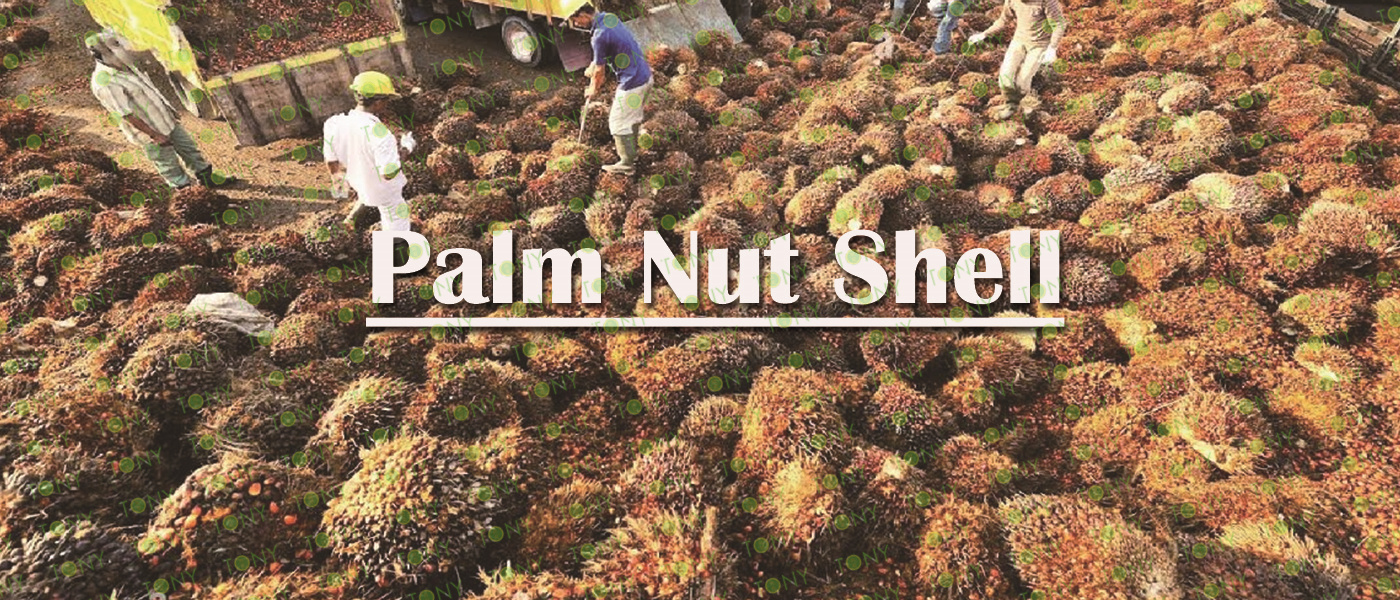
Southeast Asian Countries
Indonesia: Indonesia is the world's largest producer of palm oil, with a vast area of palm plantations. Palm husks are a byproduct of palm oil production and have a huge output. The country's main palm planting areas, such as Sumatra and Kalimantan, produce a large amount of palm husks every year. These husks have many applications in energy, fertilizer and other fields.
Malaysia: Malaysia is also a major producer of palm oil, and its palm planting industry is highly developed. palm nut shellresources are abundant, and Malaysia is at the forefront of the world in the comprehensive utilization of palm husks, such as using palm husks for biomass power generation and producing activated carbon. The country's Malay Peninsula and Sabah, Sarawak and other regions are the main distribution areas of palm husks.
Thailand: Thailand's palm oil industry is large in scale, with a large number of palm plantations in the southern region and sufficient palm nut shellresources. Thailand will use palm husks to make organic fertilizers and biofuels to promote sustainable development in the agricultural and energy sectors.
Philippines: The climate in the Philippines is suitable for palm growth, and there is a certain scale of palm planting industry, and palm husks are widely distributed. Its palm plantations in some island areas are the main source of palm husks, which are partially used in local agriculture and handicrafts.
African Countries
Nigeria: Nigeria is one of the largest palm oil producers in Africa and is rich in palm nut shell resources. The country's palm planting is mainly concentrated in the southern region, where palm husks are used for traditional handicrafts and some simple agricultural applications, such as composting, and is also exploring the use of palm husks in the energy field.
Ivory Coast: As an important palm oil producing area in Africa, Ivory Coast has a considerable output of palm husks. Its palm plantations are mainly distributed in the southern and central regions, and the application of palm husks in energy and agriculture has gradually gained attention, such as for making biochar to improve soil fertility and as biomass fuel for small power generation facilities.
South American Countries
Colombia: Colombia's palm planting industry is more prominent in South America, and palm husks are mainly distributed in plantations in its tropical and subtropical regions. The country is actively developing new uses for palm husks, such as using it as an additive to building materials to improve the thermal insulation performance of the material, and also for the production of biofuels.
Brazil: Brazil has vast land suitable for palm cultivation, and palm husks are distributed in the palm planting areas in the north and northeast of Brazil. Brazil has invested a lot in the energy utilization of palm husks, such as using palm husks to generate electricity and produce bioethanol, in order to reduce its dependence on traditional fossil energy.

I. Perspective Of Resource Recycling
1. Abundant Raw Material Sources
The palm industry is widely distributed in tropical regions around the world. Moreover, the production process of palm oil generates a large amount of empty fruit bunches. For example, in Malaysia and Indonesia, the two largest palm oil-producing countries in the world, a huge number of empty fruit bunches are produced every year. Using them to make pellets can transform the original agricultural waste into valuable products, effectively solving the problem of waste disposal.
2. Environmental Protection Value
If empty fruit bunches of palm are not utilized and are piled up around plantations or factories, they will occupy a large amount of land space and may also produce greenhouse gases during natural decomposition. After being made into pellets, it can effectively reduce the pressure on the environment caused by waste emissions. For example, when these empty fruit bunches are made into pellet fuel, the carbon dioxide emissions during combustion are relatively lower than those of traditional fossil fuels. And during its growth process (the growth of palm trees), a large amount of carbon dioxide is absorbed, which helps to alleviate climate change to a certain extent.
II. Perspective Of Pellet Product Performance
1. Good Physical Characteristics
The pellets made from empty fruit bunches of palm have an appropriate density. This makes them more convenient during storage and transportation. Compared with some other loose biomass raw materials, pelletized products are not easy to scatter and are convenient for mechanical loading and unloading and transportation. For example, during truck transportation, pellets can be closely piled up to improve transportation efficiency. They have regular shapes and uniform sizes. This is conducive to achieving uniform feeding in combustion equipment or other application equipment to ensure stable energy output or the stability of other processing processes. For example, in a biomass boiler, uniform pellets can ensure a smooth combustion process and reduce problems such as insufficient combustion caused by uneven feeding.
2. High Energy Density
Pellets of empty fruit bunches of palm contain abundant organic components such as lignocellulose. These components can release considerable energy during combustion or other energy conversion processes. Compared with the original empty fruit bunches of palm, the energy density is increased after being made into pellets. For example, when used as biomass fuel, it can provide sufficient heat to meet the heating and power generation needs in industrial production or residents' lives.
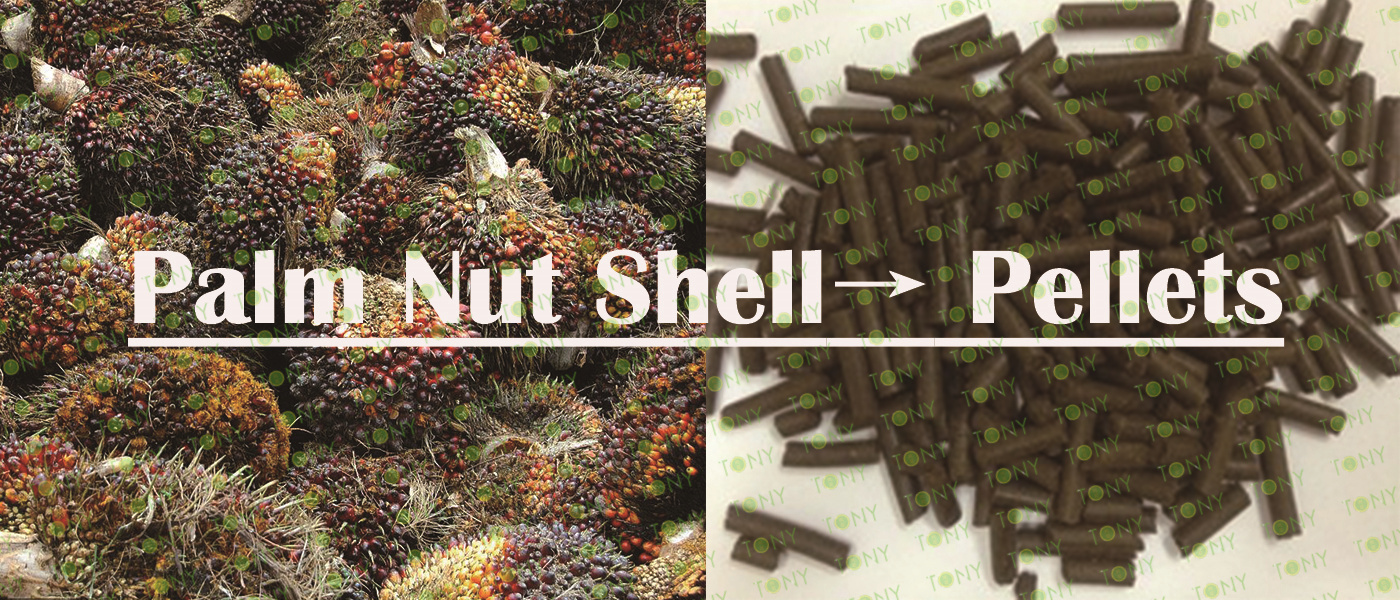
Some Factors Affecting The Yield Of Palm Nut Shell Pellets
1.The main factors affecting the yield of Palm Nut Shell pellets include raw material selection, raw material pretreatment, equipment configuration and ratio adjustment.
(1)Raw material selection is one of the key factors affecting the yield of palm nut shell pellets. The type and quality of raw materials directly affect the output and quality of pellets. For example, when palm nut shell is used as raw material, clean and impurity-free straw needs to be selected to ensure the density and molding effect of the particles1. In addition, the moisture content of the raw materials is also very important. Excessive moisture content will cause wall sticking during the granulation process and affect the output.
(2)Raw material pretreatment is also an important factor affecting output. Impurities and moisture content in the raw materials will affect the molding effect and output of the particles. Through pre-treatment methods such as crushing and screening, impurities can be removed and the uniformity of raw materials can be improved, thereby increasing particle yield.
2.Equipment configuration is also an important aspect that affects output. The design and automation level of biomass pellet equipment directly affect production efficiency and output. Reasonable equipment configuration and advanced process flow can significantly improve production efficiency and particle quality.
3.Proportion adjustment is also a key factor affecting output. During the production process, the ratio of raw materials needs to be continuously adjusted and optimized to ensure the best molding effect and output. For example, the proportions of raw materials such as Palm Nut Shell Chips and paddy husks need to be adjusted according to specific conditions to achieve optimal yield and quality.
By optimizing raw material selection, pretreatment, equipment configuration and ratio adjustment, the yield and quality of Palm Nut Shell pellets can be effectively improved.

Advantages In The Energy Sector
Source Of Renewable Energy: Palm nut shell pellets are a high-quality biomass fuel. Palm nut shells themselves are waste from the production of palm oil. After being made into pellets, they can be used as renewable energy. Compared with traditional fossil fuels (such as coal, oil, etc.), the use of palm nut shell pellets can effectively reduce dependence on non-renewable energy, which is in line with the trend of global sustainable energy development.
High Calorific Value Characteristics: Palm nut shell pellets have a high calorific value and can generate a lot of heat energy. For example, in some industrial boilers and small power generation equipment, it can be used as an efficient fuel to replace some traditional fuels, thereby providing stable energy support for industrial production and power supply. Its calorific value can usually reach about 3800-4200 kcal/kg, and its combustion efficiency is high, which means that under the same energy demand, the amount of palm nut shell pellets required is relatively small.
CO2 Reduction Benefits: During the combustion process, the amount of carbon dioxide released by palm nut shell pellets is theoretically roughly equivalent to the amount of carbon dioxide absorbed during its growth. From a life cycle perspective, this helps to reduce net greenhouse gas emissions and has positive significance for mitigating climate change.
Application Advantages In The Agricultural Field
Soil Improvement Effect: The ash from the burning of palm nut shell particles is rich in potassium, calcium, magnesium and other mineral nutrients. These elements are very helpful for improving soil fertility and can be used as a natural organic fertilizer or soil conditioner in agricultural production. Applying ash to the soil can improve the physical structure of the soil, increase the aeration and water retention of the soil, and is conducive to the growth of crop roots and nutrient absorption.
Recycling Of Organic Materials: In the agricultural ecosystem, the use of palm nut shell particles promotes the circulation of organic materials. This recycling method helps to build a healthier and more sustainable agricultural environment, reduce the use of chemical fertilizers, reduce agricultural production costs, and improve the quality and safety of agricultural products.
Environmental Benefits
Waste Reuse: If palm nut shells are not used, it will cause resource waste and environmental problems, such as stacking and occupying a large amount of land space, and may also rot in the natural environment to produce odors and harmful microorganisms. Making palm nut shells into particles realizes the effective reuse of waste and reduces the pressure of solid waste on the environment.
Reduce Air Pollution: Compared with some low-quality fuels, palm nut shell pellets produce relatively less harmful gases (such as sulfur dioxide, nitrogen oxides, etc.) when burned. This is because the chemical composition characteristics of palm nut shells themselves make them cleaner during combustion, which helps reduce air pollution and improve air quality.
Advantages In Economic Value
Cost-Effectiveness Advantage: For palm oil production companies, palm nut shells were originally waste that needed to be processed. After processing them into pellet fuel, they can be turned into treasure. This method not only solves the problem of waste disposal, but also brings additional economic benefits to the company. For example, by selling palm nut shell pellet fuel, the overall operating costs of the company can be reduced and economic benefits can be improved.
Create Employment Opportunities: The production, processing and sales process of palm nut shell pellets involves multiple links, including collection, drying, crushing, molding, etc. These links can create a large number of jobs, from raw material collection workers to processing technicians, to sales staff, etc., providing local residents with a variety of employment options and promoting the development of the local economy.
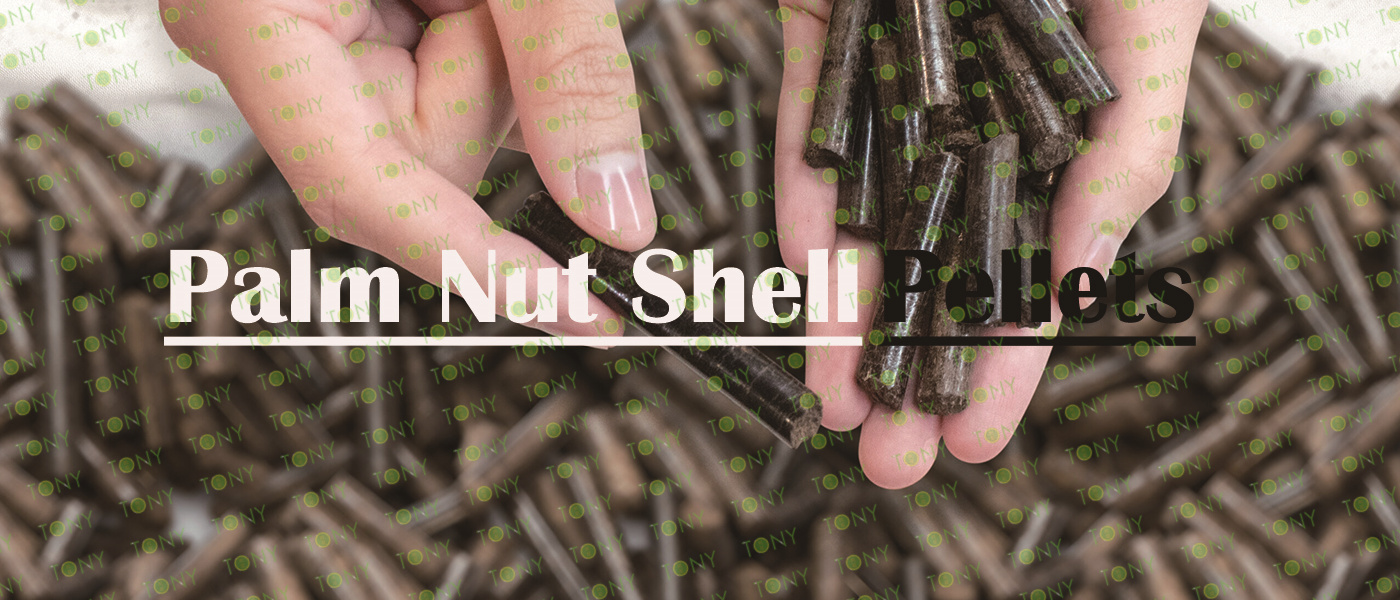

I. Advantages In Raw Material Supply
1. Abundant Resources: The palm industry is extremely developed in tropical regions around the world, especially in major palm oil-producing countries such as Malaysia and Indonesia. The palm oil production process generates a large amount of palm empty fruit bunches, providing a stable and sufficient supply of raw materials for pellet production.
2. Low Cost: Since palm empty fruit bunches are a by-product of palm oil production, using them for pellet production is relatively low in terms of raw material cost. Compared to using specially cultivated, single-purpose raw materials for pellet production, utilizing palm empty fruit bunches can save on raw material procurement expenses.
II. Environmental Performance Advantages
1. Waste Reuse:
Palm empty fruit bunches are a type of agricultural waste. Making them into pellets realizes the effective reuse of waste.
2. Reducing Greenhouse Gas Emissions:
When palm empty fruit bunches decompose naturally in piles, they generate greenhouse gases. After being made into pellets, on the one hand, it reduces the greenhouse gases generated by the natural decomposition of waste. On the other hand, when the pellets are used as biomass fuel, the amount of carbon dioxide released during the combustion process is less than that of traditional fossil fuels. Moreover, palm trees absorb carbon dioxide during their growth process, which helps to balance carbon emissions to a certain extent and has a positive effect on mitigating climate change.
III. Quality Advantages Of Pellet Products
1.Good Physical Properties:
Appropriate density: Pellets made from palm empty fruit bunches have an appropriate density, which is convenient for storage and transportation. They will not be easily scattered like some loose biomass raw materials. During storage, they can be closely stacked. During transportation (such as by truck), space can also be fully utilized to increase the loading capacity and thereby improve transportation efficiency.
2.Uniform Shape And Size:
Palm empty fruit bunch pellets have regular shapes and uniform sizes. This uniformity can ensure uniform feeding. For example, in a biomass boiler, uniform feeding can make the combustion process more stable and avoid problems such as incomplete combustion and unstable energy output caused by uneven feeding.
3.High Energy Density:
Palm empty fruit bunch pellets contain abundant organic components such as lignocellulose. These components can release considerable energy during combustion or other energy conversion processes. Compared to the original palm empty fruit bunches, the energy density is increased after being made into pellets. When used as biomass fuel, it can provide sufficient heat for heating in industrial production, power generation, or heating in people's daily lives.



I. Growing Demand In The Energy Field:
Biomass Power Generation:
With the global emphasis on and development of renewable energy, the biomass power generation market is continuously expanding. Palm fruit empty bunch pellets, as a high-quality biomass fuel, have advantages such as high calorific value, stable combustion, and environmental friendliness. They can be used as fuel supply for biomass power plants. For example, in major palm oil-producing countries such as Malaysiaand Malaysia, many enterprises have begun to use palm fruit empty bunch pellets for biomass power generation. This trend is expected to continue to grow in the future.
II. Promotion By Environmental Protection Policies:
Demand For Waste Disposal:
Making pellets from the large amount of palm fruit empty bunch waste generated by the palm oil industry can not only solve the waste disposal problem but also realize the reuse of resources, which meets the requirements of environmental protection policies. Many countries and regions are strengthening the management and utilization of waste, which provides policy support for the market development of palm fruit empty bunch pellets.
III. Application Potential In The Agricultural Field:
Soil Amendments:
After treatment, palm fruit empty bunch pellets can be used as soil amendments. Their rich organic components such as cellulose and lignin can improve soil structure, increase soil fertility, and improve the soil's water and fertilizer retention capacity, which is beneficial for the growth of crops.
There are differences in the production technology and equipment manufacturing of palm fruit empty bunch pellets among different countries and regions. Through international technical cooperation, the quality and production efficiency of products can be improved and the development of the industry can be promoted. At the same time, technical cooperation can also promote exchanges and cooperation among countries and provide support for the market expansion of palm fruit empty bunch pellets.


Working Principle Of Palm Nut Husk Biomass Pellet Line:
1.Raw Material Collection: Collect oil palm empty fruit bunches to ensure their quality and freshness.
2.Crushing: Crush the oil palm empty fruit bunches into smaller particles for subsequent processing.
3.Drying: Dry the crushed oil palm empty fruit bunch particles to remove moisture and make them reach an appropriate humidity.
4.Pelletizing: Use a pelletizer to pellet the dried oil palm empty fruit bunch particles to make particles of the required size.
5.Cooling: Cool the prepared particles to reduce their temperature.
6.Packaging: Package the cooled particles for storage and transportation.

TONY Brand 14-16Ton/Hour Palm Nut Shell pellet manufacturing plant can process Palm Nut Shell ,stlak,It is widely used in poultry feed, cattle, sheep and horse feed. It can also replace coal for burning.
1.Capacity: 14-16Ton/Hour
2.Raw materials: Rice Husk,Peanut Shell,Sunflower Husk,Coffee Husk,Hazelnut Husk,Walnut Shell,Palm Nut Shell etc.
3.Moisture: About 40-55%.
4.Application: All kinds of husk materials.
5.Finisheh pellets markets: Feed, fertilizer and fuel fields

1.Project Name: Palm Nut Shell Pellet Line
2.Raw Materisl: Palm Nut Shell
3.Moisture Of Raw Material: 40-55%
4.Capacity: 14-16Ton/Hour
5.Process: 1.Grinding Process→2.Fine Crushing Process→3.Drying process→4.Pelleting Process→5.Cooling Process→6.Packing Process
6.Main Machine: Comprehensive Chipper, Hammer Mill,Rotary Drum Dryer,TONY Pellet MachineTYJ860-III-250KW,Pellets Cooler,Packing Machine And Belt Conveyors.
7.Total Power: About 2260KW
8.Need Area: About 1800-2000m㎡
9.Project Country: Malaysia
10.Voltage: 240V,50HZ


 |
Project Layout For Customer |
|
1.Product:Palm Nut Shell Pellets Line 2.Capacity:14-16Ton/Hour 3.TONY Brand 14-16Ton/Hour Palm Nut Shell Pellet Line Project Process 4.Main Machine:Comprehensive Chipper, Hammer Mill,Rotary Drum Dryer,TONY Pellet MachineTYJ860-III-250KW,Pellets Cooler,Packing MachineAnd Belt Conveyors. 5.Total Power:About 2260KW 6.Need Area:About 1800-2000m㎡ 7.Country:Malaysia |
|


|
How to use TONY pellet line to proceed from Palm Nut Shell into pellets? It mainly contains the following steps and machines as following: 1.To Use TONY Comprehensive Chipper To Grind Palm Nut Shell With Width 30cm Into 30-40mmChips. 2.To Use TONY Hammer Mill To Crush 30-40mm Chips Into 8-14mm Sawdust. 3.To Use TONY Single Layer Rotary Drum Dryer To Dry The 45-55% Wet Palm Nut Sawdust Into 10-15% Palm Nut Sawdust. 4.To Use TONY Vertical Ring Die Pellet Machine To Products Pellets With φ14-16mm. 5.To Use TONY Galvanized Cooler To Cool Pellets From 80-90℃ to 20-30℃. 6.To Use TONY Fully Auto-Matic Packing Machine To Packing Pellets To 15-50KG/Bags. You can contact TONY to get for more details information and quotation. |
|
||||||||||||||||||||||||||||||||||||||||||||||||||
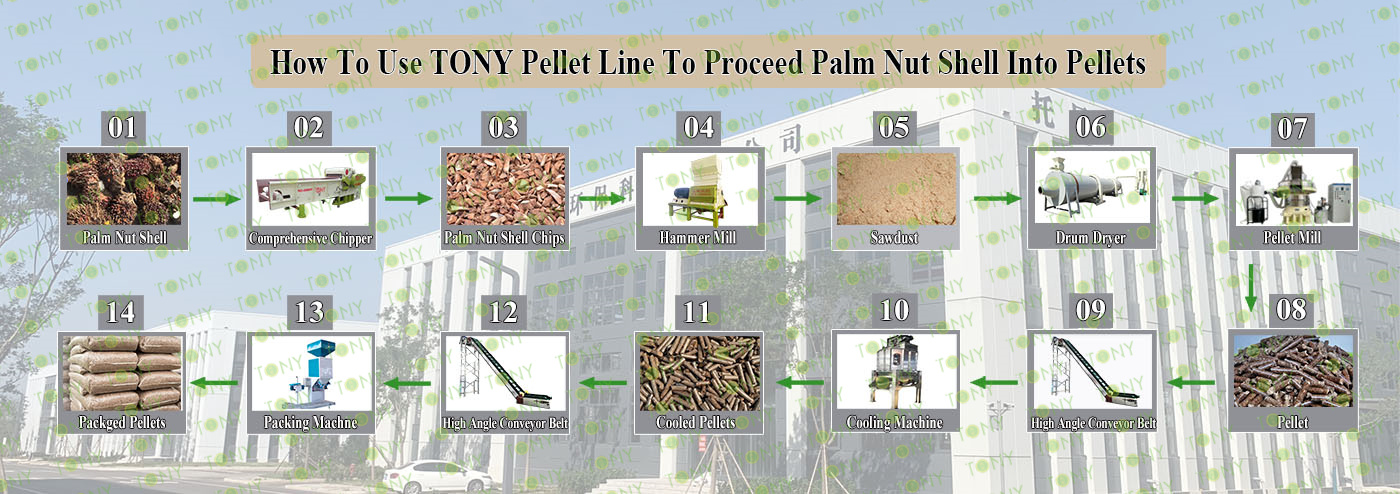


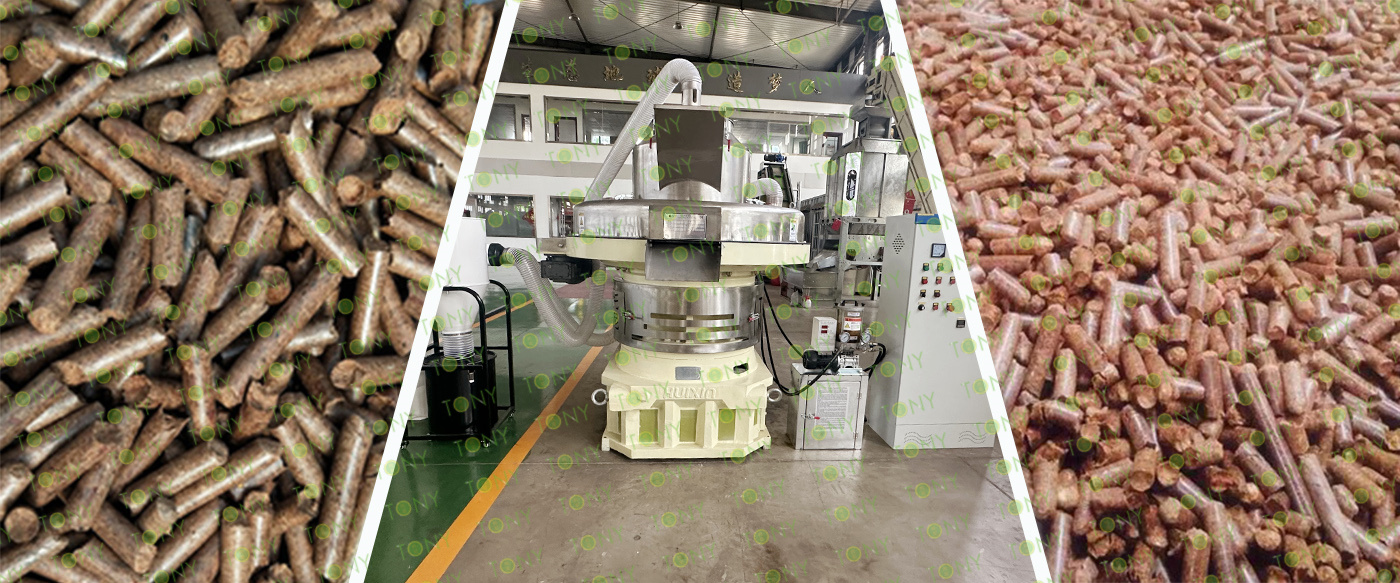
Following TONY Will Introduce For You For All The Necessary Machinery That Will Be Used For The Whole Pellet Production Line. Some machines Can Be Custom Made By Customer According To Different Customer's Detailed Demand.Contact TONY For More Details With Quotation And Layout.
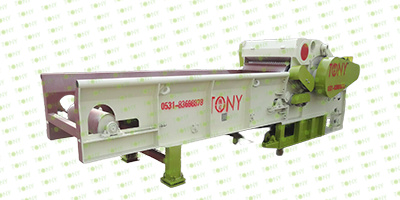 |
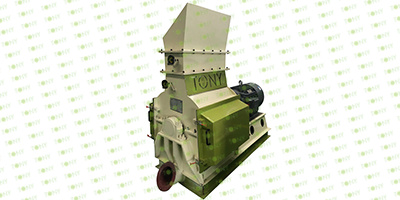 |
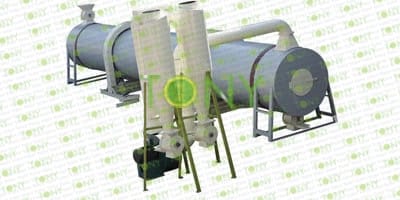 |
| Comprehensive Chipper | Hammer Mill | Drum Dryer |
|
1.To Grind Palm Nut Shell Into 30-40mm Palm Nut Shell Chips. 2.Model:TP1400-600*200kw*2set 3.Capacity:14-16Ton/Hour |
1.Crush 30-40mm Chips Into 8-14mm Sawdust. 2.Model:TFD-75-250KW *2Sets 3.Capacity:6-8Ton/Hour/Set Total Capacity:14-16Ton/Hour |
1.To Dry The 45-55% Palm Nut Shell Chips Into 10-15% Palm Nut Shell Chips. 2.Model:THGD2.5*24*1set 3.Total Power With Belt Conveyor:96KW 4.Total Capacity:14-16Ton/Hour |
 |
 |
 |
| Vertical Ring Die Sawdust Pellet Machine | Cooler Separator | Fully Automatic Packing Machine |
|
1.Model:TYJ860-III-250KW*4Sets 2.Capacity:3-4Ton/Hour/Set 3.Total Capacity:14-16Ton/Hour |
1.To Cool Pellets From 80-90℃ to 20-30℃ 2.Model:TCN-10*2Sets 3.Capacity:14-16Ton/Hour |
1.Packing Pellets To 15-50kg/Bags. 2.Model:TQBF 3.Capacity:14-16Ton/Hour |


|
1.Chipping Process: A.This process is mainly used to grind the palm nut shell into palm nut shell chips with size 25-35mm. The finish palm nut shell chips size can be adjustable by changing different sizes of screeners and adding flying knives inside the Comprehensive Chipper. B.This customer uses TONY Brand TP1400-600-200kw-2Sets: Main Parts: (1). TONY's new Comprehensive Chipper. (2). Feed and unload belt frequency control to prevent card material (3). Hydraulic system control for more thickness of raw materials (4). Electronic control system allows the equipment to be used normally (5). Contact TONY for more details with quotation. |
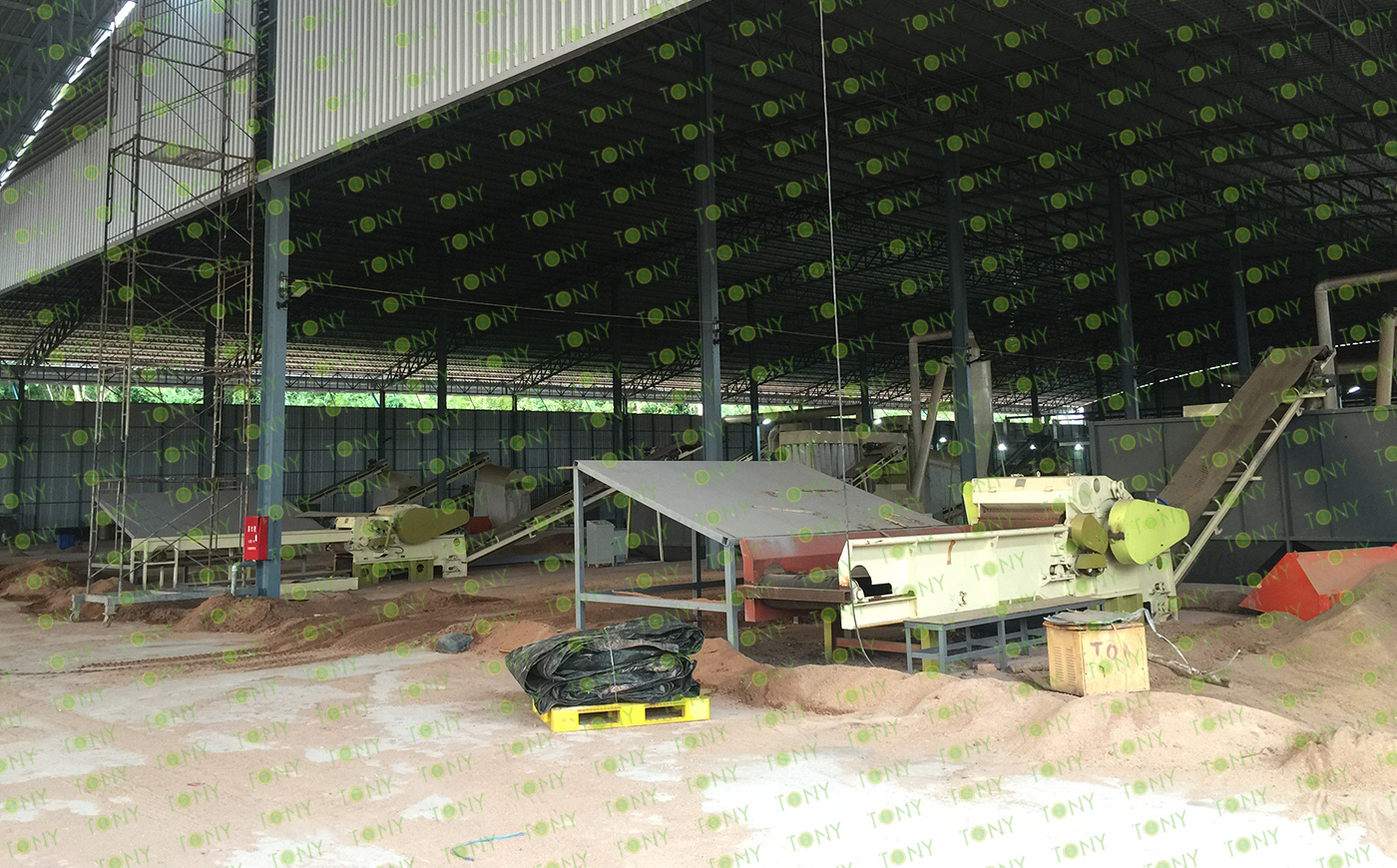

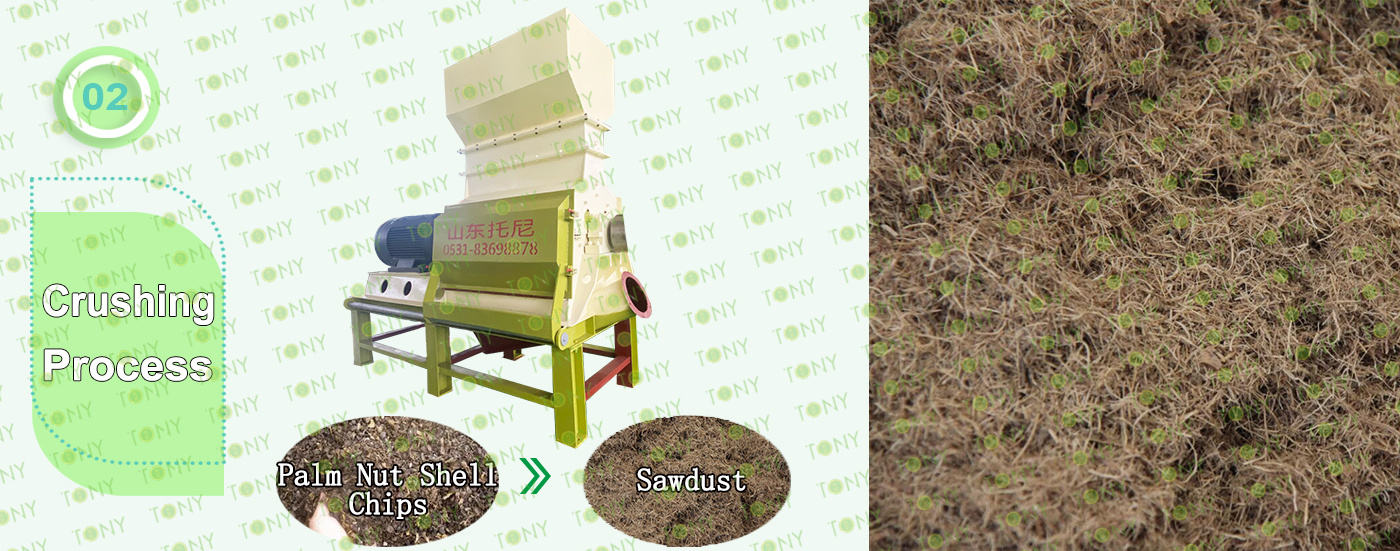
|
2.Palm Nut Shell Chips Fine Crushing Process: A.This process is mainly used to crush 30-40mm palm nut shell chips into 8-14mm sawdust. B.Capacity:14-16Ton/Hour. C.TONY use High Effective Hammer Mill TFD75-200KW-2Sets for this process. Main Parts: (1).TONY High Effective Hammer Mill. (2).90 Holes Galvanized Dust Collector. (3).Sawdust Transportation Fan Blower. (4).Cyclone With Airlock. (5).Electrical Cabinets. |
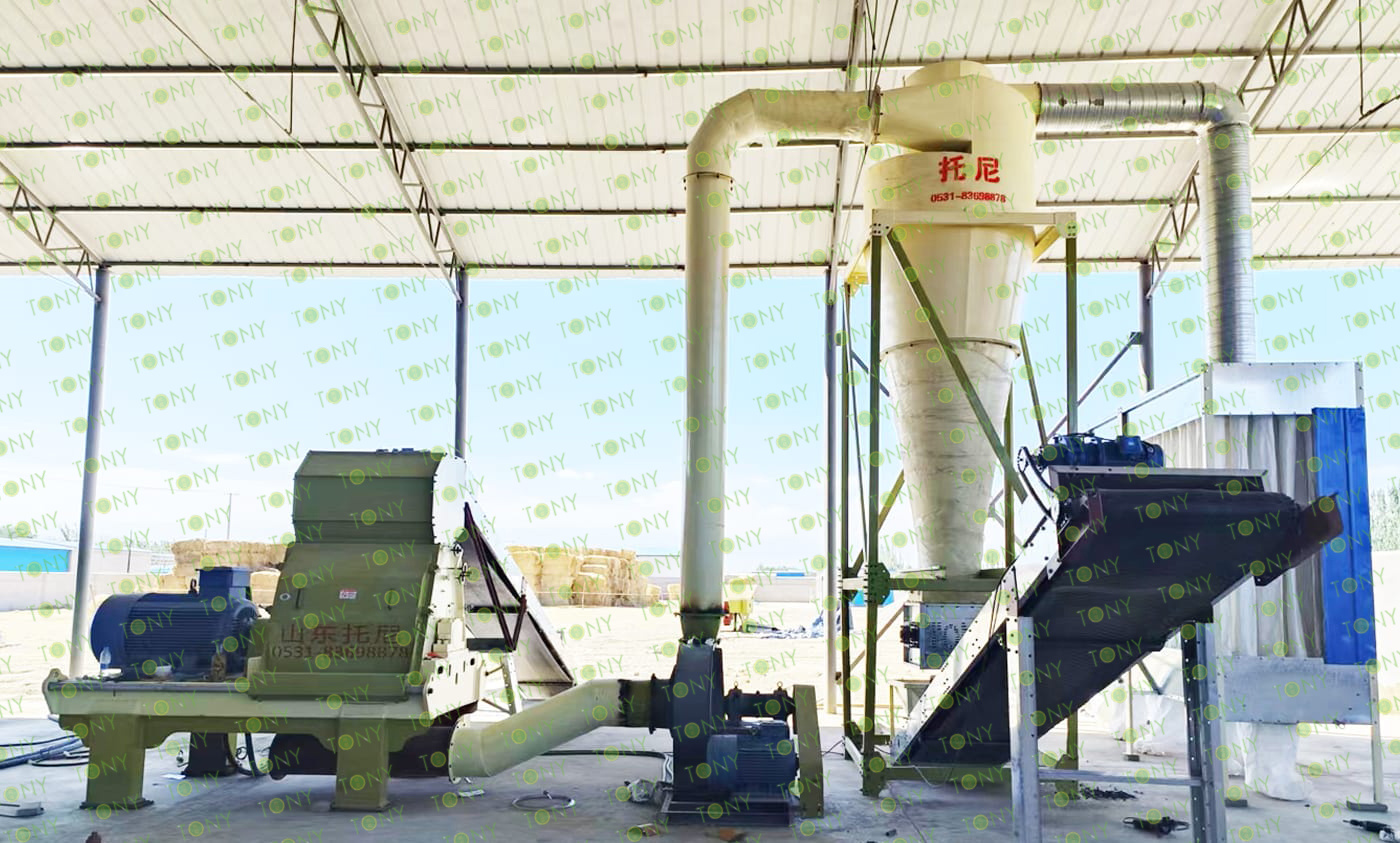

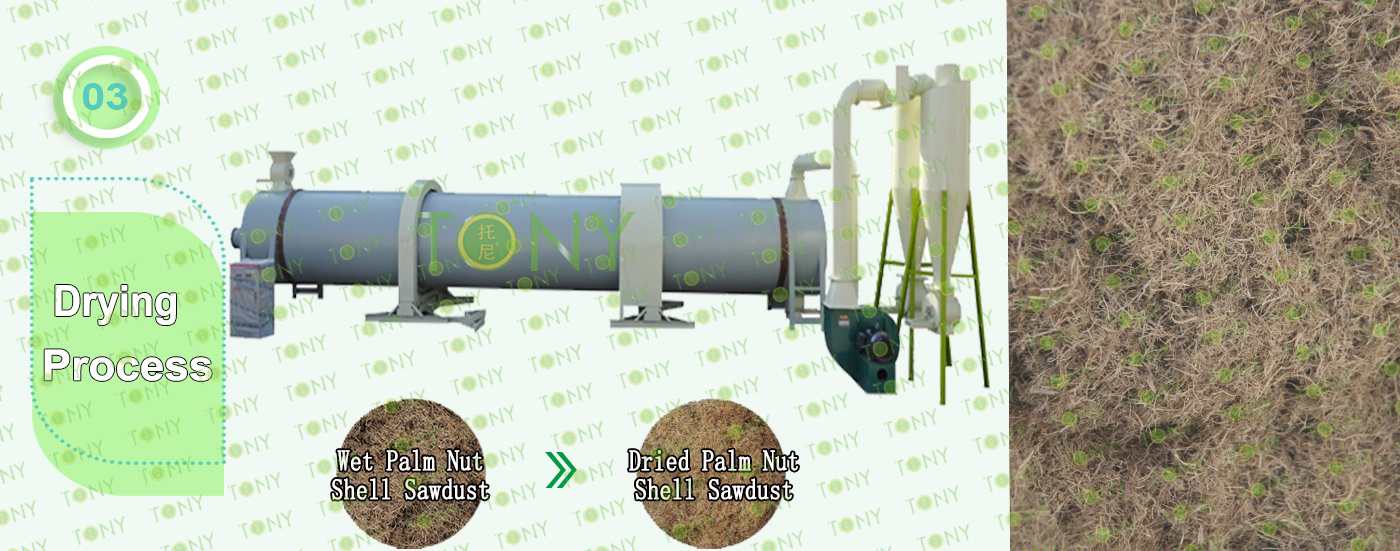
|
3.Sawdust Drying Process: A.This process is mainly used to dry the sawdust from 40-45% to 10-15%. B.Capacity:14-16Ton/Hour Per Set.This Production Line is 14-16Ton/Hour. C.TONY uses a 2.5*24m single layer rotary drum dryer. The customer uses biomass waste palm nut shell as burning raw material with a 5.8*2*2m hot stove. TONY's hot blast stove is made of firebrick pan and H steel plate. It has 3 layers of fire blocking device to prevent fire from entering the dryer. TONY dryer uses spiral tube material with higher heat rate and less deformation compared to iron plate splicing welding of other manufacturers. Main Parts: (1).TONY's Rotary Drum Dryer Main Body.(Reducers With Motors and Pips.) (2).TONY's Palm Nut Shell Waste Hot Stove. (3).Fan Blower+Cyclone With Airlock. |
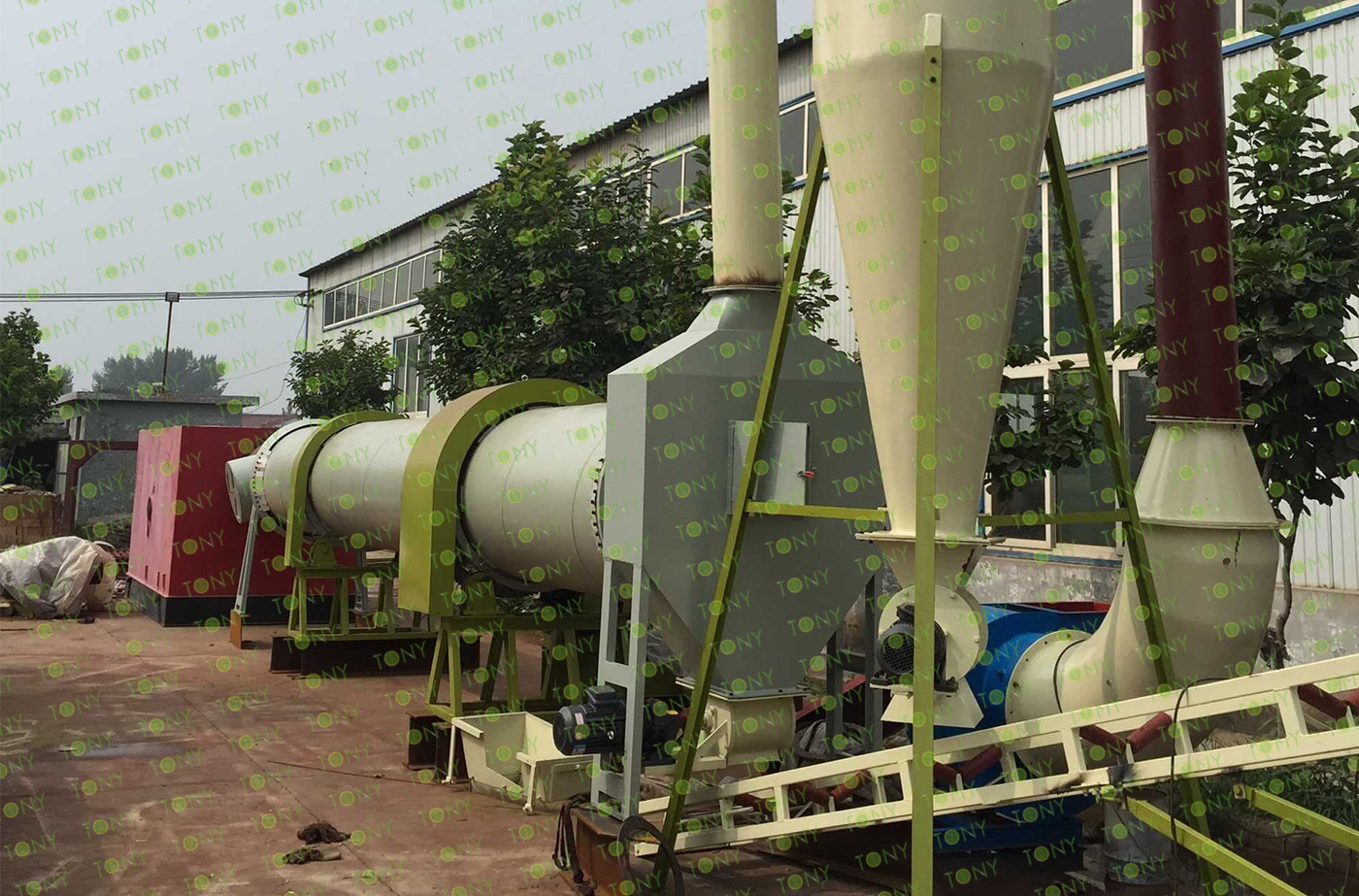

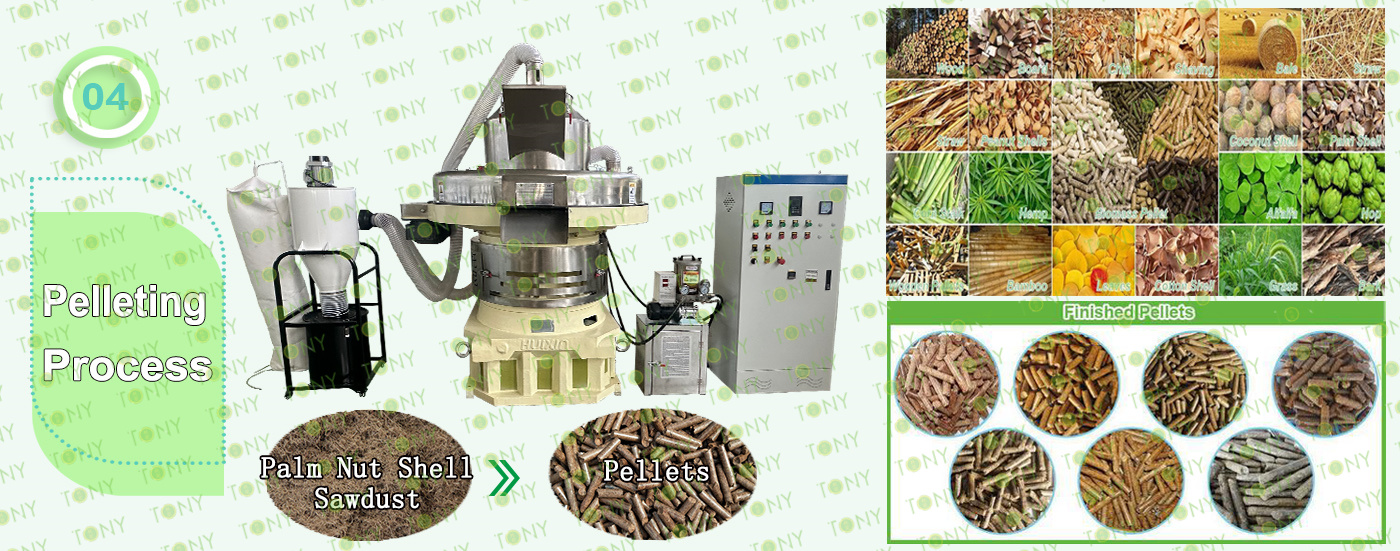
|
4.Pelleting Process: A.This process is mainly used to product pellets with φ14-16mm. B.Capacity:14-16Ton/Hour. C.The Customer Chooses 4 Sets Of TONY Brand Vertical Ring Die Pellet Machine TYJ860-III-250KW With Capacity 3-4Ton/Hour. Main Parts: (1).TONY's new vertical ring die pellet machine. (2).Cyclone and bags dust collectors. (3).Bearings automatic lubrication system. (4).Electrical cabinets. You can choose TONY new type SS304 pellet machine or old type MS pellet machine. |
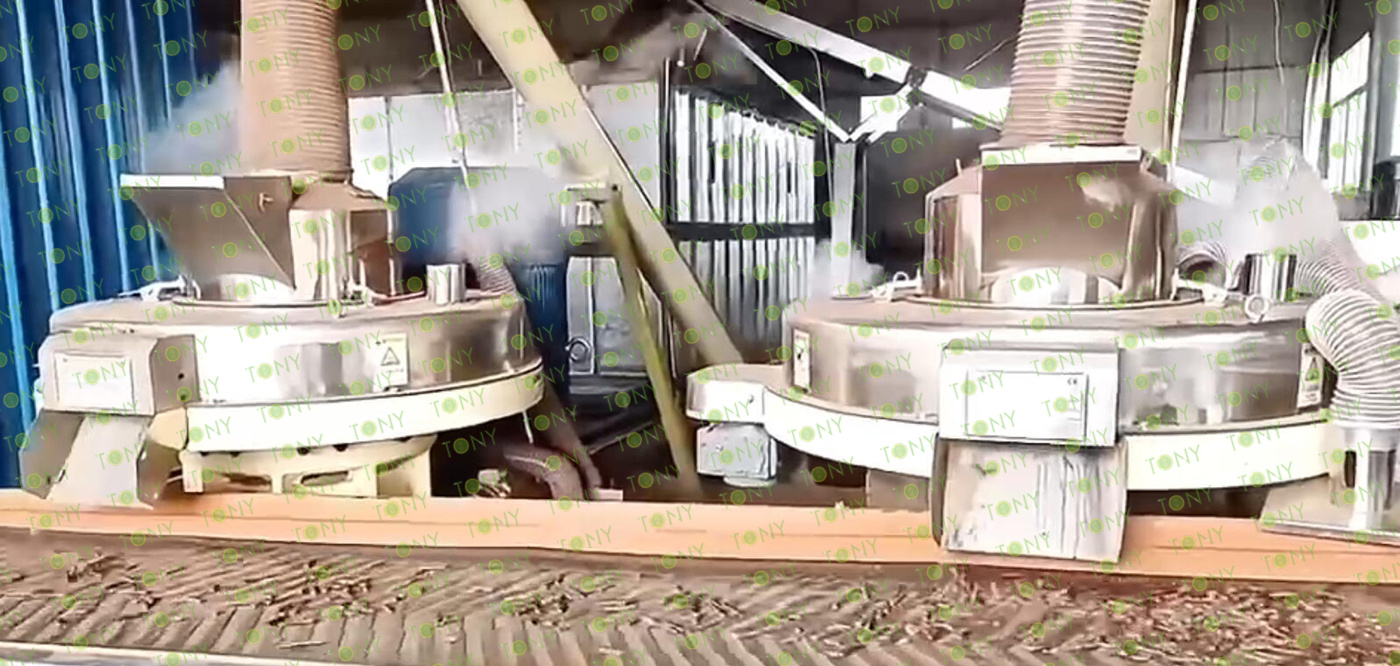

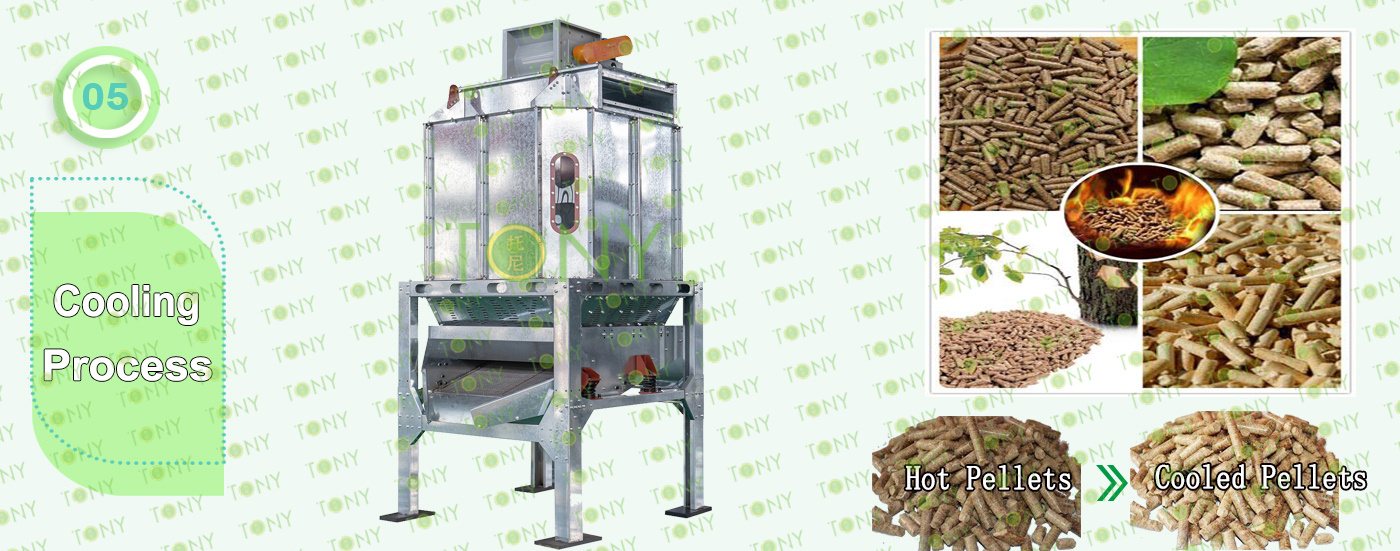
5.Cooling Process:
A.This process is mainly used to to cool pellets from 80-90℃ to 20-30℃
B.The customer chooses 1 set of TONY Galvanized Cooler Separator with capacity 14-16Ton/Hour.
Main Parts:
(1). TONY's new Galvanized Cooler Separator With Vibrating Screen.
(2). Cyclone and bags dust collectors.
(3). Fan Blower.
(4). Connect Pipes.
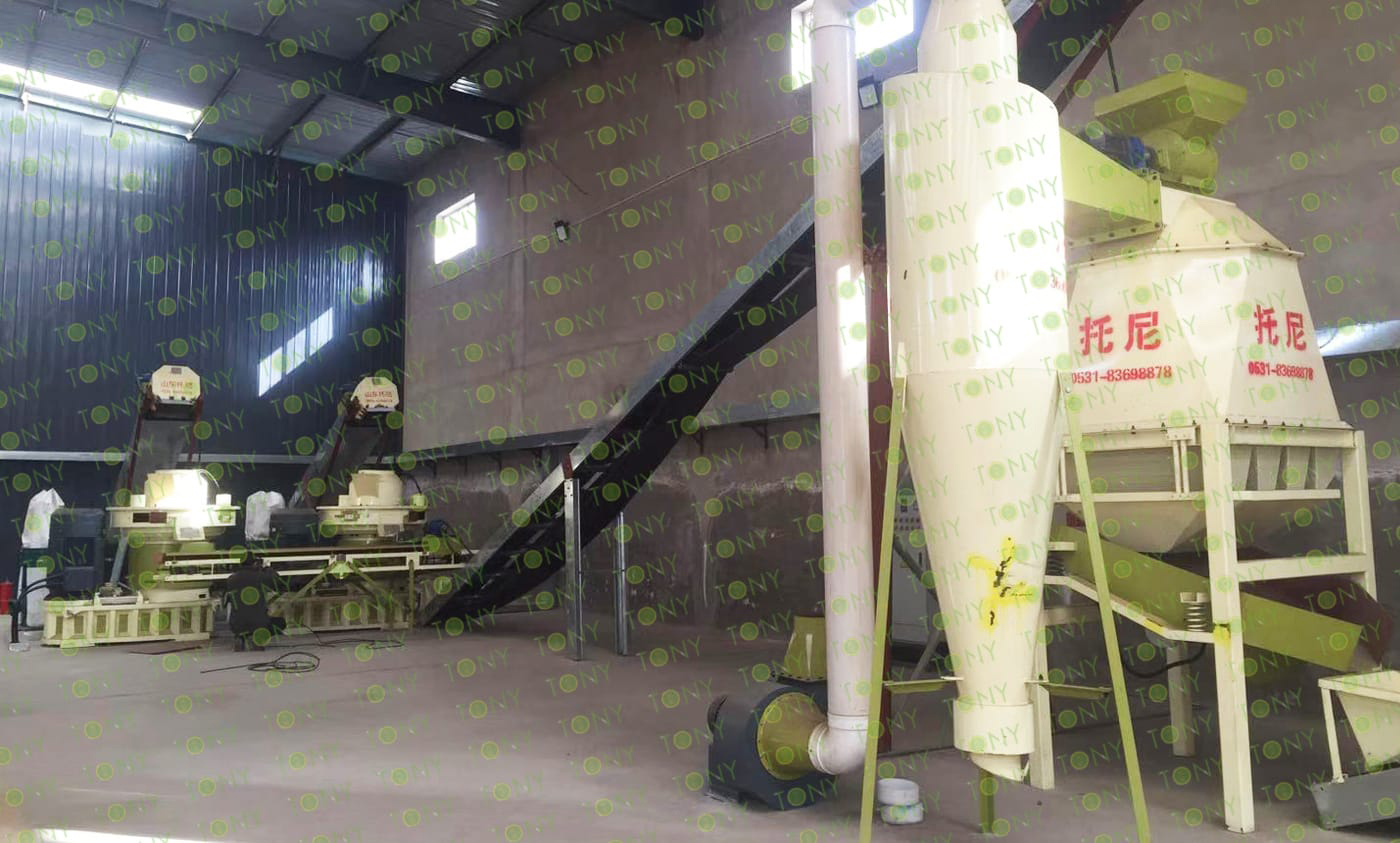

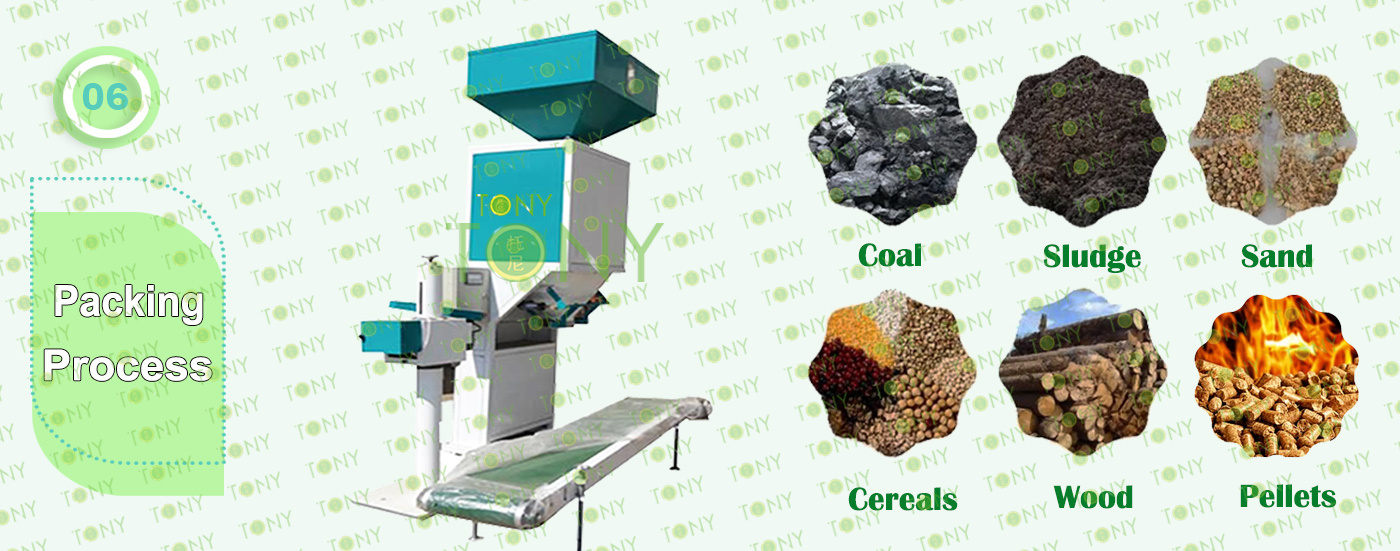
6.Packing Process:
A.This process is mainly used to pack pellets to 15-30kgTon/Bags.
B.The customer chooses 1 set of TONY Fully-Automatic Packing Machine With 14-16Ton/Hour.
Main Parts:
(1) TONY's new TONY Fully Automatic Packing Machine.
(2) Sew Machine, Buyer Can Also Choose Hot Seal Machine For Chosen
(4) Feeding Inlet Silo With 1㎥.
(5) Electrical Cabinets.
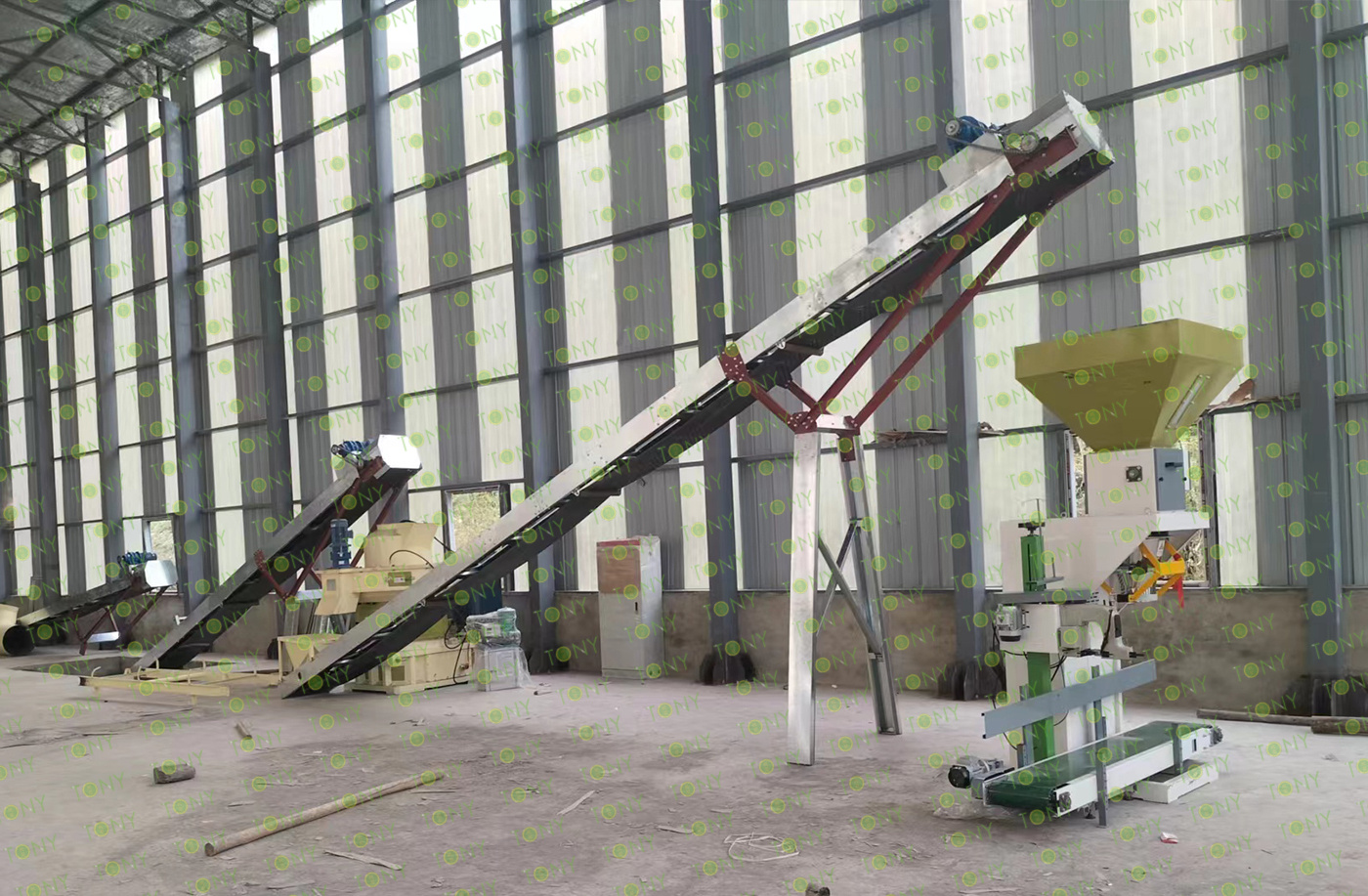

TONY Detailed Design 3D Layout With Detailed Size For 10-12Ton/Hour Palm Nut Pellet Line According To Cusomer Factor Size
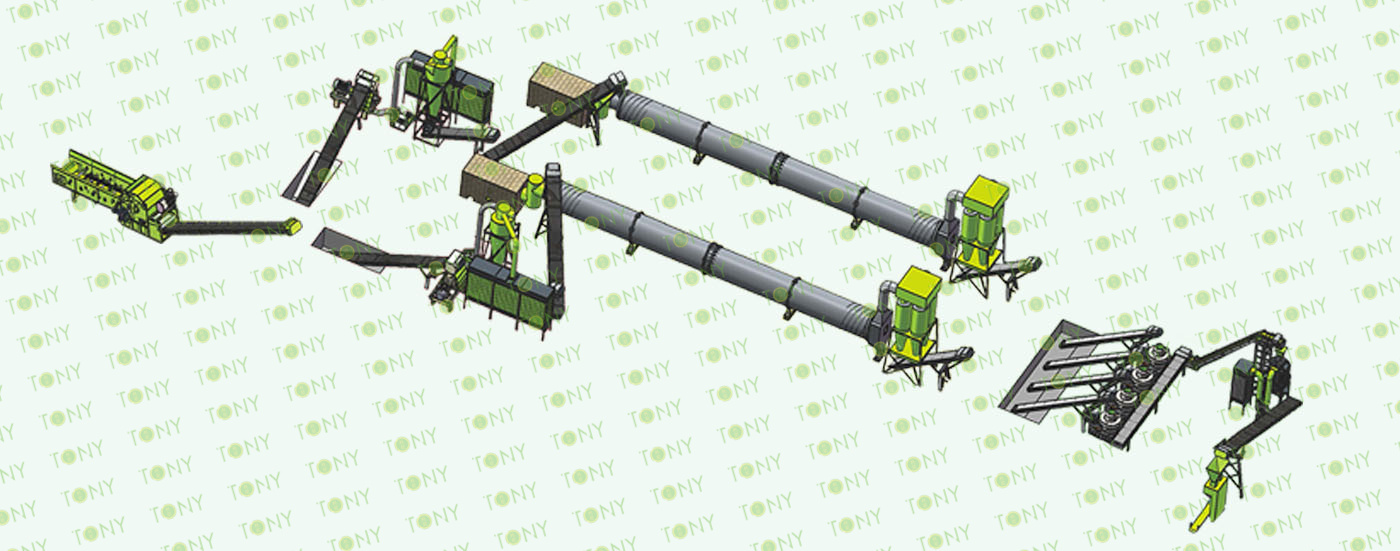

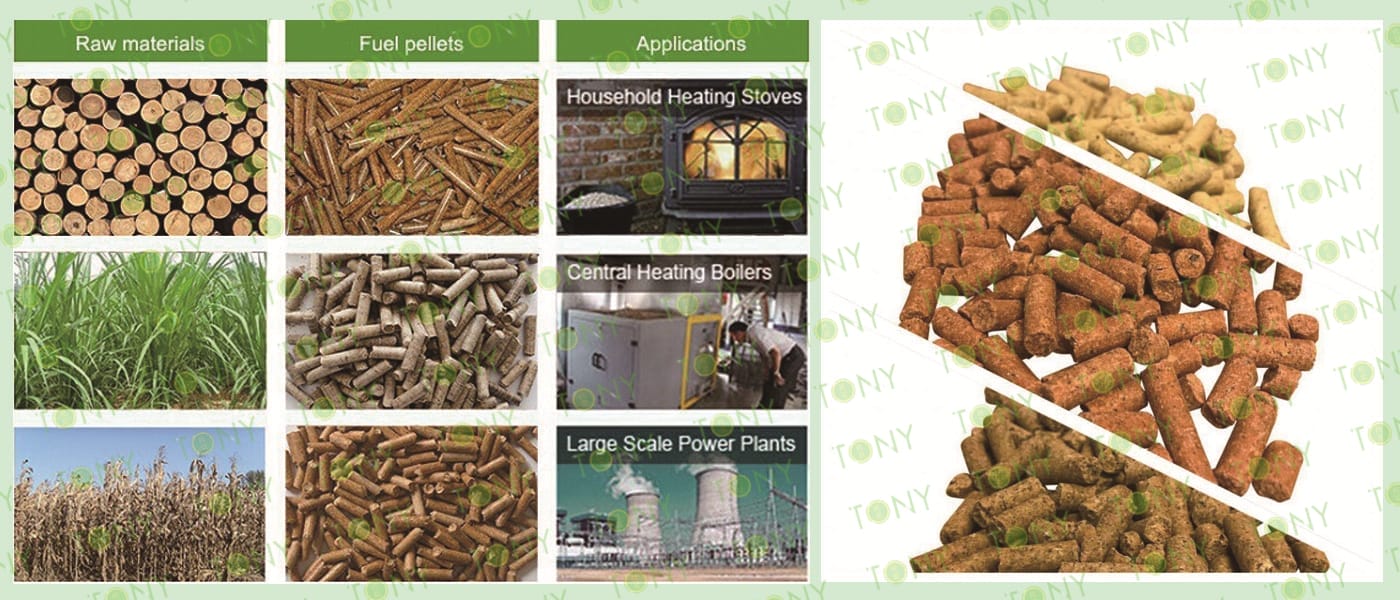
Positive Impact
Greenhouse Gas Emission Reduction
Palm nut shell pellets are biomass fuel. As palm trees grow, they absorb carbon dioxide through photosynthesis. When palm nut shell pellets are burned as fuel, the amount of carbon dioxide released is theoretically roughly equivalent to the amount of carbon dioxide absorbed by the palm tree as it grows. From a life cycle perspective, this carbon cycle process helps reduce net emissions of greenhouse gases and is of positive significance in combating climate change.
The use of palm nut shell pellets can significantly reduce carbon dioxide emissions compared to traditional fossil fuels such as coal. For example, coal burning releases a large amount of carbon that has accumulated underground for a long time, and the use of palm nut shellparticles can alleviate the increase in carbon emissions caused by energy consumption to a certain extent.
Reduce Air Pollution
Palm nut shell pellets produce relatively few harmful gases when burned. It has a lower sulfur content and emits significantly less sulfur dioxide during combustion compared to coal. Sulfur dioxide is one of the main pollutants that causes acid rain. Reducing its emissions can help reduce the frequency and harm of acid rain.
Burning palm nut shell pellets also produces relatively little nitrogen oxides. Nitrogen oxides cause photochemical smog and acid rain, harming air quality and ecosystems. Using palm nut shell pellets as an energy source can alleviate these environmental problems to a certain extent.
In addition, burning palm nut shell pellets produces less particulate matter (such as PM2.5 and PM10) than some inferior fuels. These particulate matter can cause damage to the human respiratory and cardiovascular systems, and reducing their emissions will help improve air quality and human health.
Waste Reuse And Waste Reduction
Palm husks were originally a waste product from the palm oil production process. Making it into granules for use in the energy field achieves effective reuse of waste and avoids land occupation and environmental pollution caused by random discarding or accumulation of fruit shells. According to statistics, the large amount of husks produced by the palm oil industry will occupy a large amount of landfill space if not utilized.

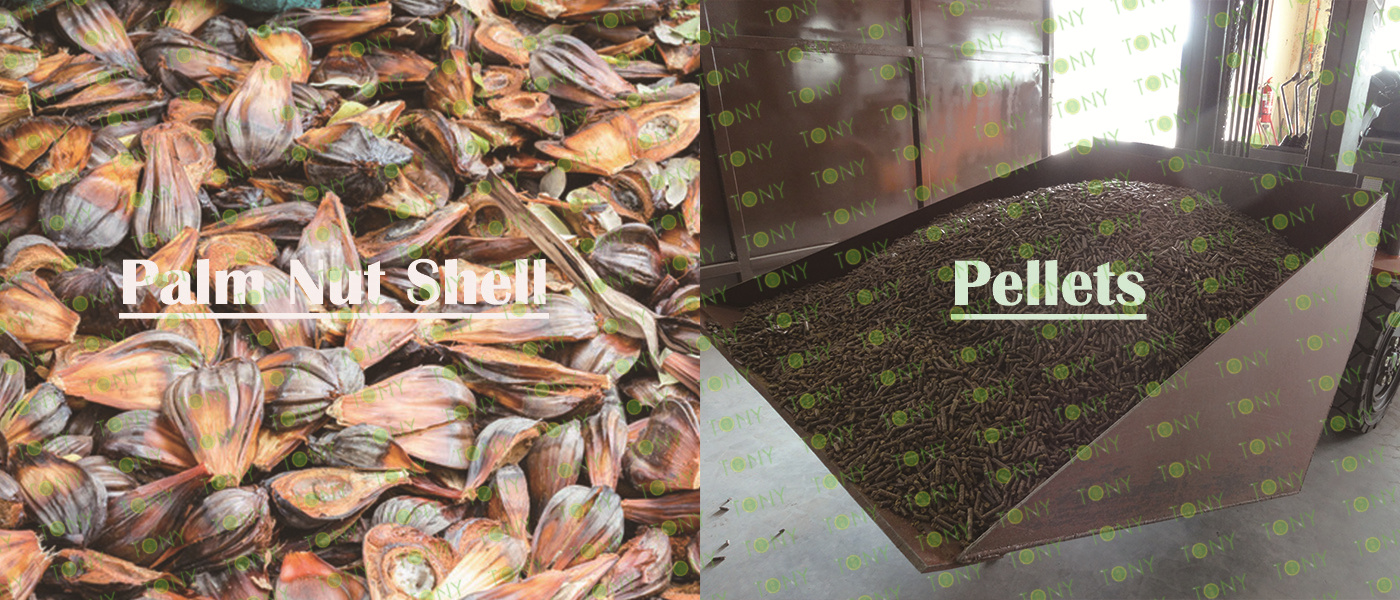
The market prospect of palm nut shell is relatively broad. The following is a specific analysis:
Energy Field
Demand For Biomass Fuel Is Growing: With the global emphasis on renewable energy and the improvement of environmental awareness, the biomass fuel market is showing a rapid development trend. palm nut shell, as a high-quality biomass fuel, has the advantages of high calorific value, low ash content, and low sulfur content. It can be widely used in power generation, heating and other fields, and its market demand is also increasing.
Policy Support: Governments of various countries have introduced a series of policies to support the development of renewable energy, such as subsidies and tax incentives, to encourage companies to use biomass fuels instead of traditional fossil fuels. These policies provide strong support for the market promotion of palm nut shell as a biomass fuel, and further promote the development of its market prospects.
Activated Carbon Production
High-Quality Raw Materials: Palm nut shell has a rich pore structure and a high carbon content, which is one of the ideal raw materials for the production of activated carbon. Activated carbon has a wide range of applications in many fields such as environmental protection, chemical industry, food, and medicine, such as water treatment, air purification, gas masks, catalyst carriers, etc., and the market demand continues to grow steadily.
Technological Progress: With the continuous advancement of activated carbon production technology, the utilization rate of raw materials such as palm fruit shells and the quality of activated carbon have been significantly improved, which makes the application of palm fruit shells in activated carbon production more extensive and competitive, and further expands its market space.
Gardening And Soil Improvement
Gardening Medium: Palm fruit shells that have been properly treated can be used as medium materials in horticultural cultivation. They have good air permeability, water retention and drainage, and can provide a good growth environment for plant roots and promote plant growth and development. There is a certain market demand in the field of horticultural planting such as flowers and vegetables.
Soil Conditioner: Palm fruit shells can also be processed into soil conditioners to improve soil structure, increase soil fertility and water retention capacity, improve soil permeability and water permeability, and help increase the yield and quality of crops. It has potential market prospects in the field of agricultural planting.

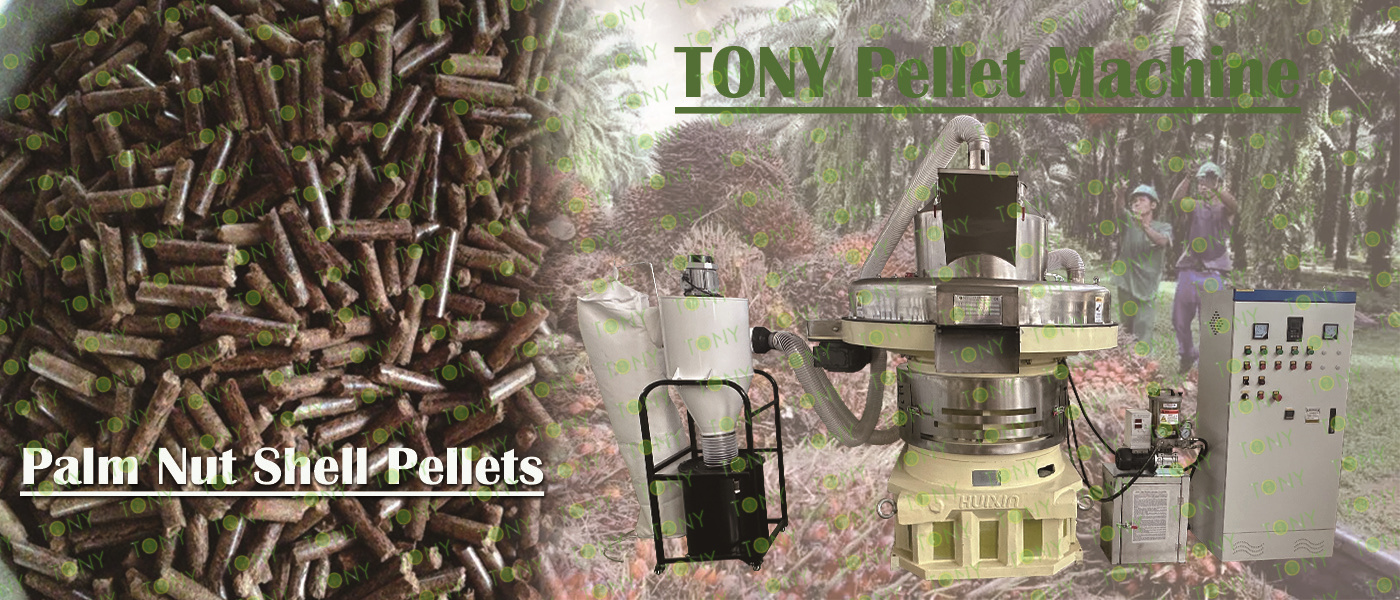
Profit Model
Product Sales: Shell palm nut shell pellets directly to energy suppliers, industrial enterprises, power plants, household users and other customers to obtain sales revenue. According to market conditions, the selling price of palm nut shell pellets is generally around 600-1000 yuan/ton.
By-Product Sales: In the production process of palm nut shell pellets, some by-products such as palm nut shellash are also produced. These by-products can be sold as fertilizers, soil conditioners, etc., to increase additional sources of income.
Energy Self-Use: If the company itself has certain energy needs, some palm nut shell pellets can be used for internal energy supply, such as boiler combustion, power generation, etc., thereby reducing the company's energy procurement costs and improving economic benefits.

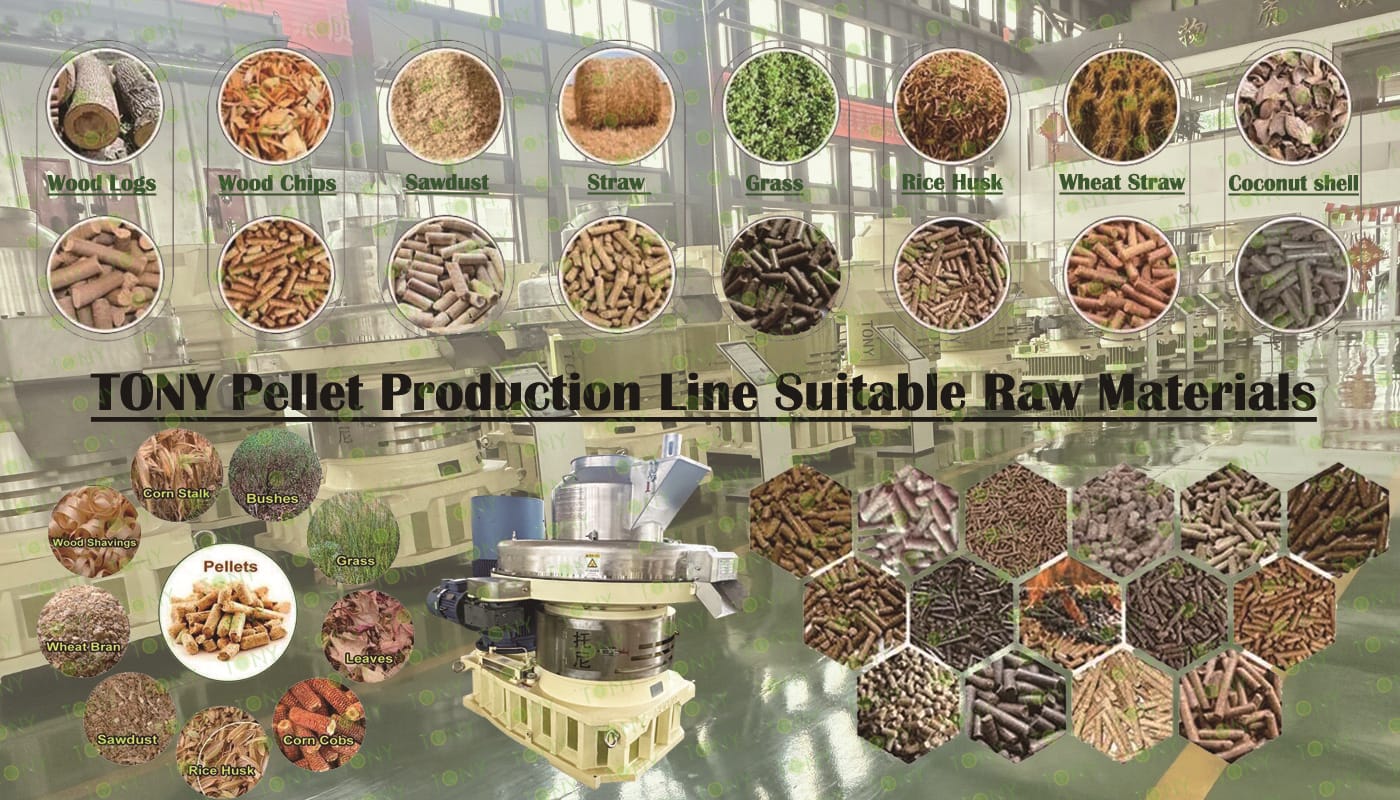
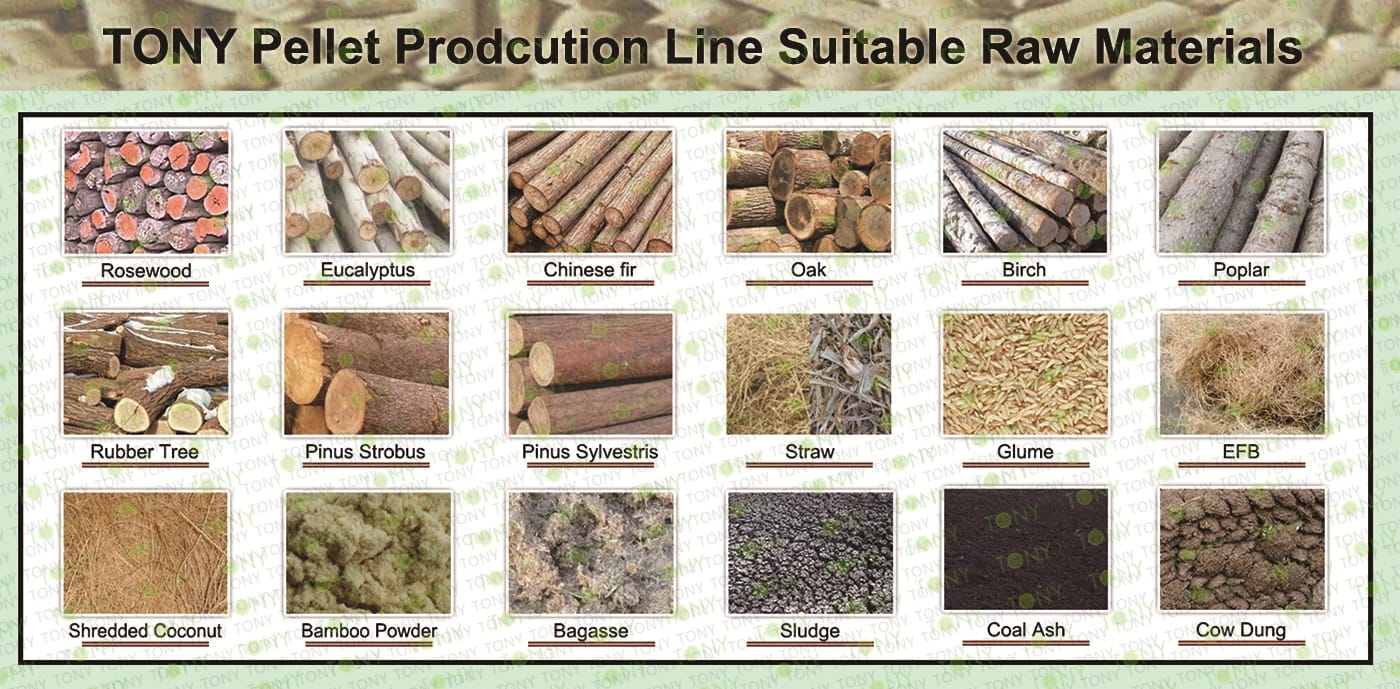



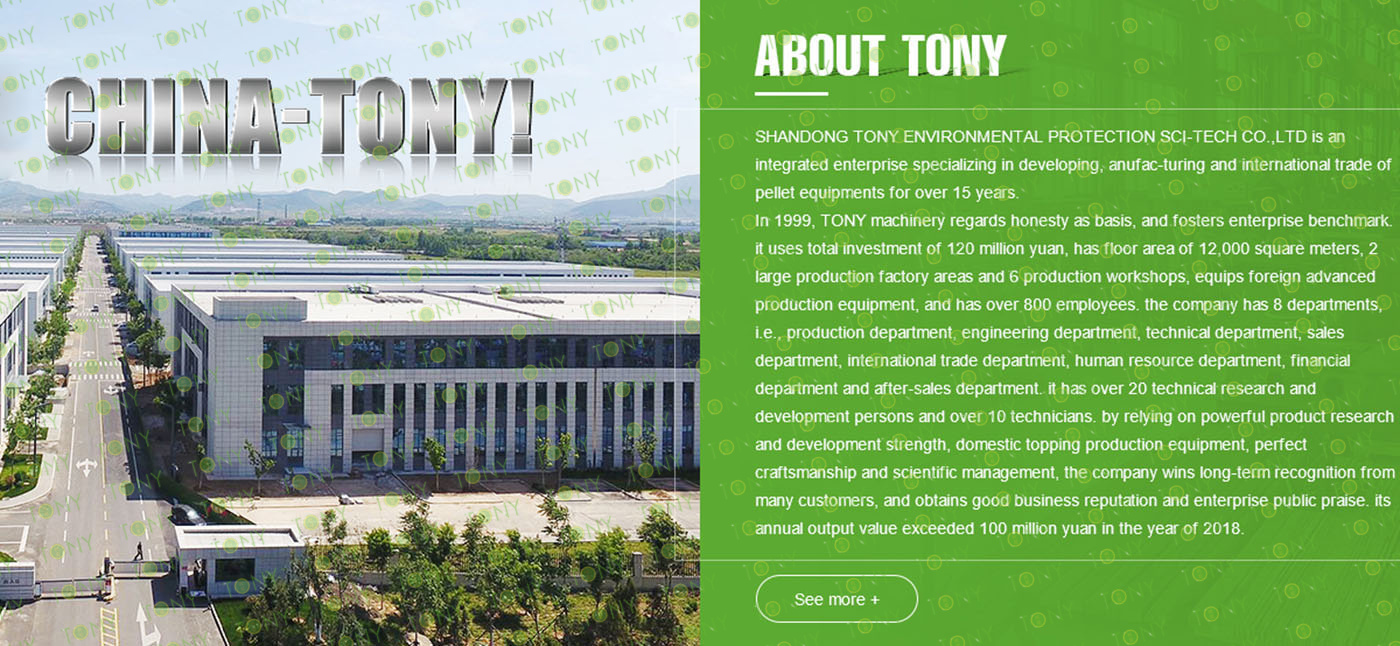
2025 Tony Machinery - All Rights Reserved. Map